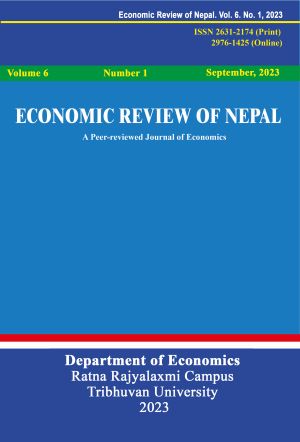Leveraging Exogenous Insights: A Comparative Forecast of Paddy Production in Nepal Using ARIMA and ARIMAX Models
DOI:
https://doi.org/10.3126/ern.v6i1.67970Keywords:
paddy production, ARIMA, ARIMAX, agricultural land, forecast accuracyAbstract
Using annual time series data from 1975 to 2022, this study analyzed the ARIMA (1,1,7) and ARIMAX (1,1,7) models to improve paddy production forecasts in Nepal. The ARIMA model was initially employed to forecast paddy production. The availability of agricultural land was subsequently included as an exogenous variable in the ARIMAX model (after a significant endogeneity test) to increase precision. In contrast to the ARIMA model, which predicted paddy production of 5787.64 metric tons per hectare for the year 2022, the ARIMAX model predicted 5681.17 metric tons per hectare. Compared to the ARIMA model's MAE (0.0295), MAPE (0.797), and RMSE (0.0373), the ARIMAX model exhibited better accuracy with lower values of MAE (0.0247), MAPE (0.667), and RMSE (0.0301). The results emphasize how crucial it is to include pertinent exogenous variables to capture important dynamics influencing agricultural output. The study has important ramifications for Nepalese policymakers and agricultural planners since it suggests that the ARIMAX model can provide additional insight for policies that maximize production and optimize land usage, hence promoting food security and economic stability.
Downloads
Downloads
Published
How to Cite
Issue
Section
License
Copyright (c) 2023 Department of Economics, Ratna Rajyalaxmi Campus

This work is licensed under a Creative Commons Attribution-NonCommercial 4.0 International License.
This license enables reusers to distribute, remix, adapt, and build upon the material in any medium or format for noncommercial purposes only, and only so long as attribution is given to the creator.




